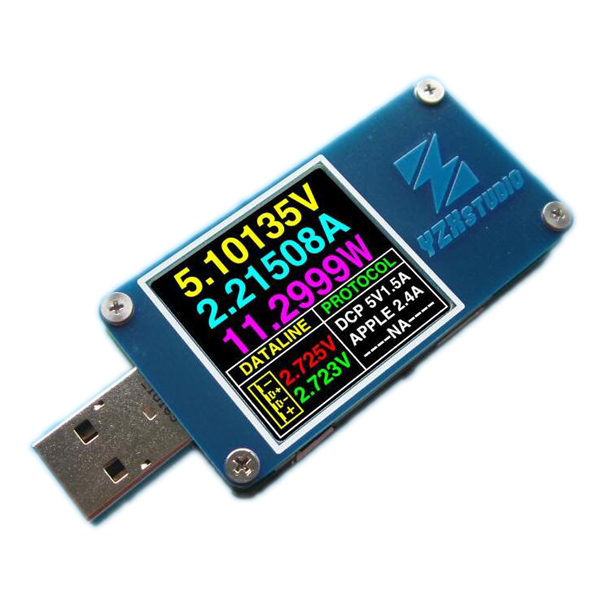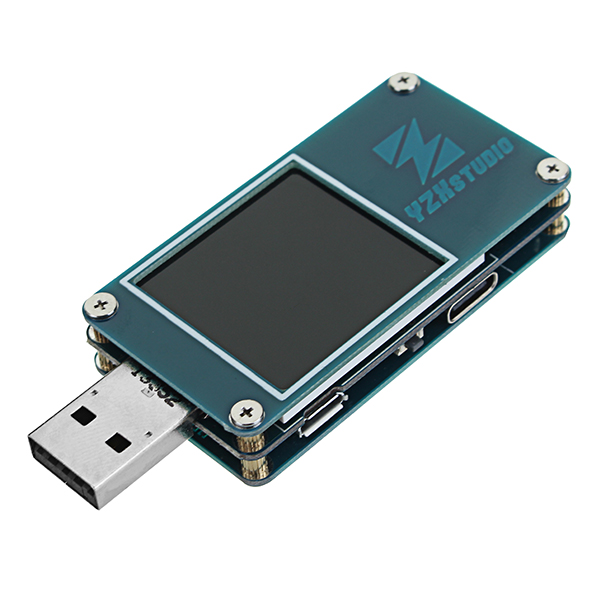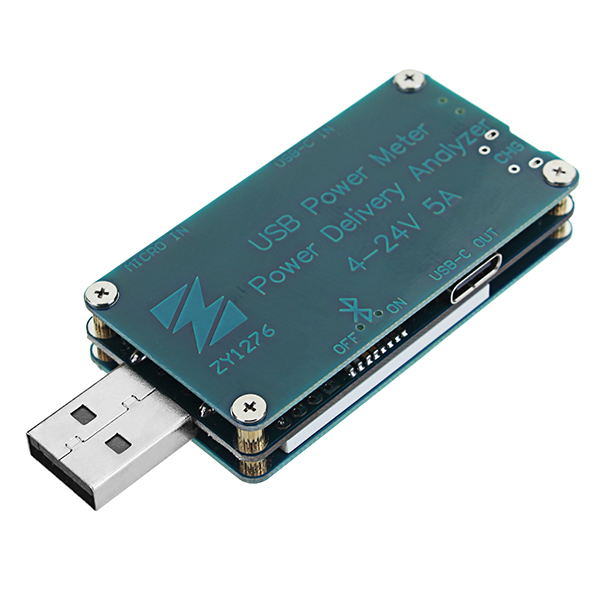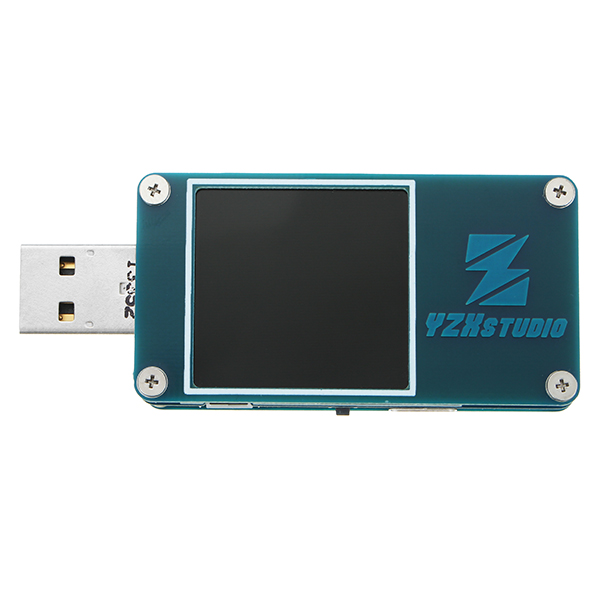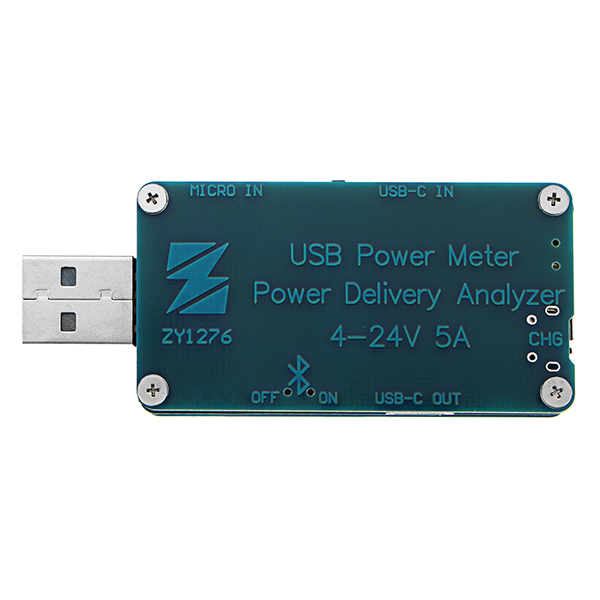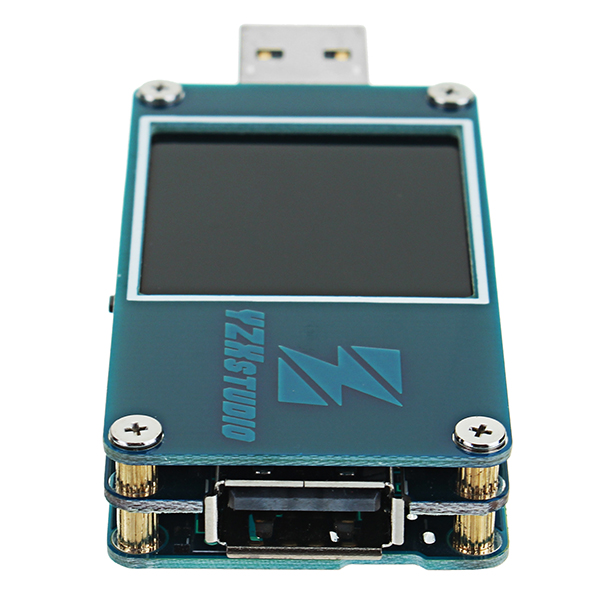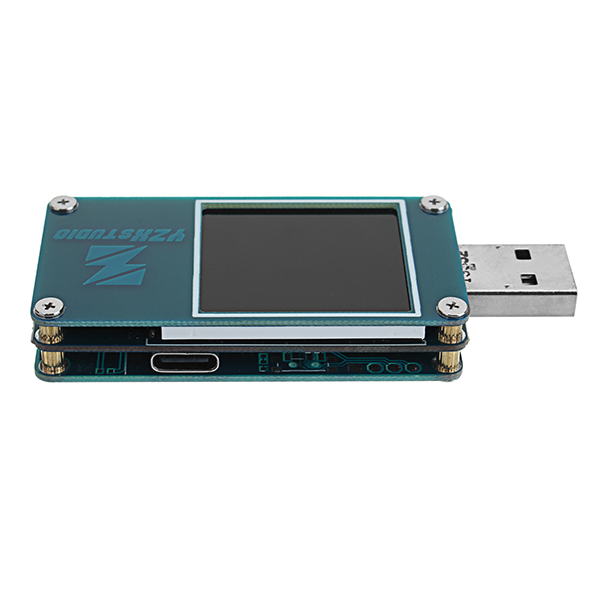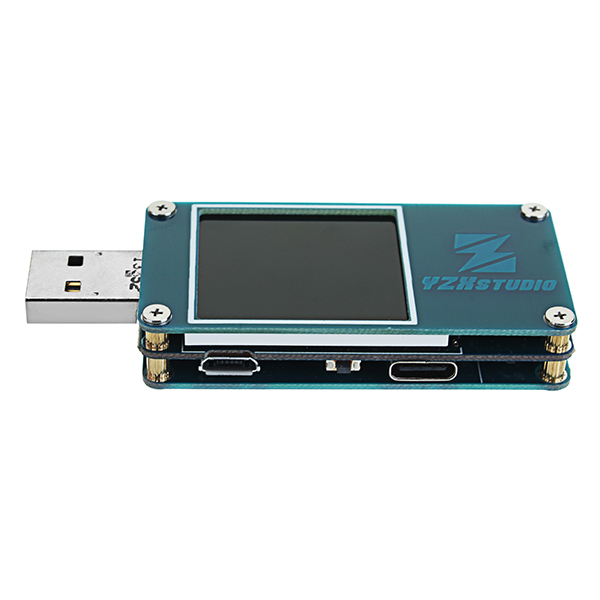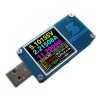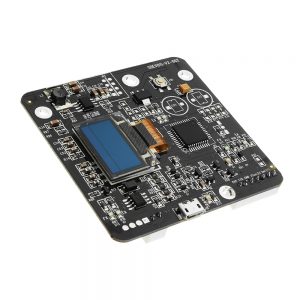YZXstudio ZY1276 Color Meter QC3.0 PD Fast Charging Dragon USB Current And Voltage Capacity Detector
$67.46
Description:
ZY1276: 0.01mA current resolution. The Type-C PowerDelivery decoy monitoring capture trigger detection, QC2.0, QC3.0, FCP, AFC, VOOC, DASH, fast charge trigger detection, deception, senior enthusiasts recommend USB test artifact.
USB2.0 interface, with almost full function fast charge trigger detection function, higher current resolution, Type-C PD adapter can be measured.
Accelerated charging:
Plug in Computer USB port Or Non-original USB charger, Automatically change the charging identification signal to Original charger, So that the phone is believed to plug into the original charger to speed up charging. Note that this function does not change the output voltage, does not support the ordinary charger to QC2.0 charger, and can not enlarge the output current.
Charger type:
Can be inserted into the unknown USB port or mobile power USB port, detection of this USB port specific charging identification signal, easy to identify what mobile phones are available for recharging?. When using this feature, it is recommended not to pick up your cell phone, or your cell phone will interfere the identification.
Safety monitor:
When the input voltage is too high or too low, the temperature is too high, the output current is too large or too small to maintain the set time, it will activate the USB safety monitoring and protection function, cut off the output to prevent accidents. Can be used for mobile phone charging at night, completely filled with power; protection of voltage and current input not causing damage to the mobile phone charger adapter is disconnected from overheating; stop charging. If you want to resume the output after protection, please long press the button at D+D- voltage to restore the output.
D+D- voltage:
That is, the data line voltage, based on this voltage, can distinguish most charger types. You can refer to this voltage to assist in determining the USB port charge identification mode.
Plastic shell:
A plastic shell version of dust, anti – entry, good performance, not touch the circuit, it is not easy to interfere with circuit work. PCB frame version without shell, but the 3 board structure of the core circuit protection is also very good, better heat dissipation.
Interface:
Divided into USB3.0 and USB2.0, USB3.0 down compatible with USB2.0, USB3.0 can be used to test the USB3.0 device operating current, USB2.0 interface is more suitable for testing common charger and USB2.0 device operating current.
Voltage:
Enter the supported voltage range, it is recommended to work within the nominal value, if less than the nominal value may not work, higher than the nominal value, it will low precision, or even burned.
Electric current:
Input support current range, it is recommended to work within the nominal value, greater than 3A can also be normal display, but USB can not withstand large current, may burn USB port. The circuit board sampling resistor supports continuous 6A. If larger current is needed, the external sampling resistor can be changed to support the 20A.
Resolving power:
The change of voltage or current capacity value, the smaller the resolution on behalf of the higher resolution of voltage and current capacity change more subtle.
Accuracy:
The percentage of reading accuracy and reading range last beat. The smaller the percentage, the higher the accuracy, the smaller the range of the beat and the more stable the readings are.
Line loss:
Contains current sampling loss and USB contact resistance loss. The smaller the value, the smaller the voltage loss after representing the flow through the USB table.
Ampere hour capacity:
Ampere per hour, 1A current maintained for 1 hours, then 1Ah, 1Ah=1000mAh, the domestic mobile power and battery capacity units commonly used. Battery capacity and mobile power capacity are commonly used.
Watt hour capacity:
Watt per hour, 1W power maintenance for 1 hours is 1Wh, 1000Wh=1 degrees of electricity, compared to Ah expression is more accurate, so the world general. Because the power = voltage x current, so the Ah* voltage =Wh. This parameter is more accurate and convenient to measure the power supply. It can also measure the efficiency of the charger according to the energy meter.
Charging time:
When the charging current is larger than the set of trickle shielding current, the time begins to go. Using this function, you can measure the time required for the device to be filled. It can also be used to accumulate the hours of equipment work.
Temperature:
The temperature of the built-in chip, if no load, no heating, the readings approximate ambient air temperature.
Memory:
At present, all models are high cost FRAM ferroelectric memory, one billion similar to the infinite number of erasing and writing life, so as to ensure the preservation of a second volume, 300 years is not bad romance.
Static power consumption:
The default brightness lights up the screen after the USB meter consumes the current. The machine uses a 32 bit processor + external ADC, all styles are a new low power consumption as low as 2-2.5mA off screen, arbitrary input voltage is 2-2.5mA, if used to measure the mobile power, regardless of whether how much voltage fast charge per hour, more 2.5mAh can be simple and accurate.
Line measuring function:
With constant current source, it can detect the internal resistance of the data wire, line loss, voltage drop and so on. The player chooses the higher quality data line.
Type-C PD test:
You can use USB with 2 double headed Type-C lines to test PowerDelivery, the default PD charger does not output and must be connected to the device to output, so the individual insertion table is generally not lit. If access to the Type-C device is not lit, insert any Type-C plug inserted into the USB table and insert it again.
Bluetooth serial function:
You can send the test data even on a computer or mobile phone and draw a curve on a computer or cell phone. Host computer development, and can only use the serial assistant +excel drawing temporarily, Note that Bluetooth can not be used to upgrade USB tables, and can only be upgraded with stlink.
Performance parameter:
Size: 75*30*15mm
Weight: 55g contains iron, the bare metal 22G
Voltage range: 3.5-24V, limit voltage 28V
Voltage resolution: 0.01mV (18bit)
Current range: average plus and minus 0-5A, can integrate the instantaneous current 24A (continuous more than 5A, USB port can not bear)
Current resolution: 0.01mA (0.15mA or so, 18bit)
Capacity range: 0-999999Ah 0-999999Wh
Capacity resolution: 0.1mAh, 0.1mWh
Instructions:
Measuring voltage and current:
The USB plug is plugged into any USB port, the mother seat, the handset, and other devices, and the voltage and current parameters are read out directly
Measuring the output capacity and efficiency of mobile power supply:
It is recommended that the resistance be used with a dummy load. The USB male head plug the power supply, the female seat is inserted into the dummy load until the discharge of the full mobile power source is ended and the undervoltage shutdown is performed. The next time you open the machine, the display capacity is the Ah and Wh for the mobile power output.
Calculate battery capacity and efficiency of mobile power supplies:
Ah data X output voltage / battery voltage Efficiency = mobile power battery Ah(output voltage is generally 5V, you can look at the capacity table second screen average voltage, battery voltage is generally 3.7V, efficiency is generally press 85-90%, I store high-end mobile power by 95%), or Wh data / efficiency = battery Wh(so Wh is easier to calculate), battery Wh / battery voltage = battery Ah, Ah / 1000=mAh. If the built-in battery capacity and voltage are known, the efficiency of the mobile power can be calculated:(Ah data X output voltage) / (battery capacity X battery voltage) = mobile power efficiency Or, Wh data / Battery Wh= mobile power efficiency
Measuring the efficiency of the power adapter / charger:
Coordination Electric meter(the goods in your distribution box) and Dummy load to Use. Only after the meter is connected with the measured battery charger, the charger is connected to the output of the USB table and the dummy load, run for a period of time, check the USB table Wh accumulated data, and then check the meter away how much electricity, 1 degrees =1000Wh, USB meter / meter reading efficiency charger change = accurate. (in fact, the number of meters rotary table how much more convenient, the general meter circle is the monogram 0.00x degree)
Measuring data line /USB transfer line / other USB table internal resistance:
Coordination with Dummy load to Use. First of all, the USB table plug power, switch to the line resistance function, and then plug in the precise false load to the required test current (recommended greater than 0.5A less than 2A), reading stable long, press the button record reference voltage, current. Then unplug the USB meter, insert the data line / transit line / other USB table directly into the power supply, then insert the USB meter into the line to be tested, and the dummy load is adjusted to the current as much as the reference current. The line loss resistance of the wire to be tested and the current under test can be read out
Measuring battery capacity:
The use of TP4056 linear charging circuit to no battery charge to full capacity through the table, reading capacity for battery capacity, using this method can probably measured mobile phone charging capacity (as with the USB charger, because the mobile phone is generally not a linear charge, and standby electricity consumption interference)
Measuring micro device current and standby current:
Up to 0.1mA high resolution, high precision current, easy to detect almost all small USB device operating current / standby current, such as reader, wireless mouse receiver, Bluetooth or network adapter.
Test the charging time / capacity with a trickle screen function:
The parameter interface switches to the next group by pressing the button.
Quick screen rotation:
Display D+D- voltage interface and display large font voltage and current interface, press the button to rotate to display the direction
Boot state:
The power is switched on via the USB male head. The display is displayed for about 1 seconds and the LOGO enters the parameter interface
Display parameter toggle / close display:
Parameter interface, press button to switch, display parameter / function and put out screen
Restore backup settings; restore factory settings:
When you display LOGO, press and hold the button until the Setting is released, press the button to switch to 09–, press the restore backup settings, press the button to switch to 07–, press the restore factory settings, and notice that the factory settings are not calibrated. After the shipment is calibrated, the owner will backup the calibrated settings, and it is recommended that you do not easily use the 08– backup settings to overwrite the correct correction parameters
Data calibration function settings:
An electronic load instrument, an adjustable power supply.
Press and hold the button, then turn on the power, about 5 seconds into the settings, then let go, and then display the list of options
Short Press button to switch to the 10V voltage reference The adjustable power supply is adjusted to the exact 10V. First do not take any load, Long press the button long, and the system automatically records the current voltage as standard 10V
Short press the button to switch to the 2A current reference, the electronic load CC constant current mode, tune to the exact 2A, access to the USB mother, long press the button long, the system automatically records the current is standard 2A.
Package included:
1 x YZXstudio ZY1276 Color Meter
